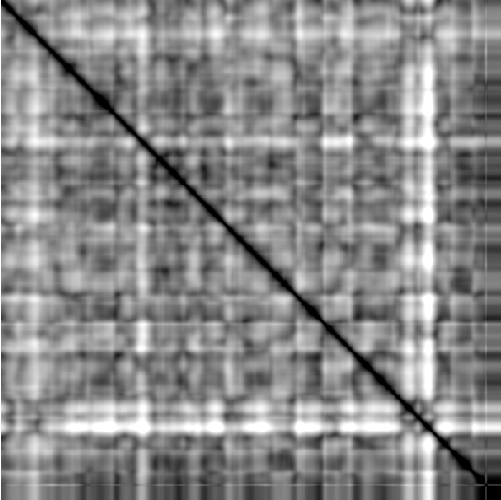15. Die Krähe. (The Crow)

Variiertes Strophenlied in c-Moll mit drei Strophen. [more]
Fourier tempogram (8 sec) correlated to deviations in rhythm and tempo. [more]
Singer: Gerhard Hüsch (Baritone), Piano: Hanns-Udo Müller. Recorded on vinyl, April-September 1933.
Source, License: EA Terms of Use
Information about our segmentation of »15. Die Krähe«
Variiertes Strophenlied in c-Moll mit drei Strophen.
Es lässt sich eine dreiteilige Form erkennen: ABA' mit einem instrumentalen Vor- und Nachspiel (I A1 A2 | B | A1 A3 I2 in der Feinsegmentierung).
Die dreiteilige Struktur stimmt mit der Stropheneinteilung überein.
Das instrumentale Vorspiel I stimmt in den ersten vier Takten mit der Strophe A1 überein, wobei die Gesangsmelodie von der rechten Hand des Klaviers übernommen wird.
A2 stellt eine leichte Variation von A1 dar.
In B wechselt trotz gleicher Art von Begleitung die Stimmung: Dur statt Moll.
In A3 wird A1 sowohl bzgl. der Harmonik als auch bzgl. der Melodik stark variiert.
Das Nachspiel I2 stellt eine leichte Variation des Vorspiels I dar.
Lyrics: Project Gutenberg
Tempogram
This feature corresponds to rhythmic properties of a musical piece as well as tempo. A tempogram is computed similar to a spectrogram by short-time Fourier transform or using autocorrelation function. It represents periodic occurances of high energy in the waveform and hence is used to estimate tempo and beat positions. To reduce jumps between a certain tempo value and its multiples, a cyclic variant is used where we identify all tempo multiples similar to the computation of chroma from pitch features. Subsequently, the resulting tempo features are quantized, smoothed (in temporal direction), and normalized with respect to the ℓ2-norm.
In the spirit of the transposition-invariant chroma-based SSM, we compute something similar for cyclic tempo features also. Although the properties of this matrix are not discovered yet, we present this representation to show that the transposition index carries some meaningful information. We guess that this can be used to separate information about rhythm and tempo. In this case, we use a standard HSV colormap.
Literature
- Geoffroy Peeters: Time variable tempo detection and beat marking, ICMC 2005.
- Peter Grosche, Meinard Müller, Frank Kurth: Cyclic tempogram – a mid-level tempo representation for music signals, ICASSP 2010, pp. 5522–5525.
- Peter Grosche, Meinard Müller: Tempogram toolbox: Matlab implementations for tempo and pulse analysis of music recordings., ISMIR 2011.
